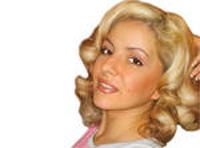|
|
Hair transplantation can help both men and women

Treatment of hair lossOne of the primary cause of hair loss is a high amount of the male hormone, dihydrotestosterone (DHT) within the hair follicle. DHT is produced from testosterone in the prostate, various adrenal glands, and the scalp. After a period of time, an over abundance of DHT causes the hair follicle to degrade and shortens the active phase of the hair. The most important cause of hair loss is inadequate nutrition. Even a partial lack of almost any nutrient may cause hair to fall. But hair grows normally after a liberal intake of these vitamins. A high protein and and an iron rich diet is recommended for hair loss. An adequate intake of raw vegetables, fresh fruits, salads, green leafy vegetables should be included in the diet on a regular basis. Another important cause of falling hair is stress, such as worry, anxiety and sudden shock. Stress leads to a severe tension in the skin of the scalp. This adversely affects the supply of essential nutrition required for the healthy growth of hair. For men, hair loss is male pattern baldness. Yes, there are other types of hair loss, including rare conditions such as alopecia totalis and alopecia universalis, where the entire scalp and entire body, respectively, become completely bald due to a viral condition that is irreversible. There is also patch baldness, in which hair falls out in patches of the scalp. This is caused by stress or poor nutrition or adverse scalp conditions. But the hair will usually grow back once the cause has been rectified. Male pattern baldness that is the condition responsible for over 98% of all hair loss in men. It gets its name from the pattern of hair loss, which ultimately results in a horseshoe of hair that resides on the sides and back of the head, while the top of the head is completely bald. Some men begin MPB by losing the hair in their hairline. Others start in the crown. The most familiar hair loss pattern is where the hair begins to recede in the hairline and the crown at roughly the same time. The hair in the mid-scalp or anterior scalp is often the last to go. But go it will, eventually leaving a man with the horseshoe of hair that is the telltale sign of typical male pattern baldness. The chief difference in womens androgenic hair loss from mens (both are hormone related) is that women tend to experience thinning that occurs in no particular pattern or part of the scalp. Unlike men, the scalp may not actually be totally denuded of hair, just thin to the point where the scalp is visible. Like men, however, the resulting hair loss is generally irreversible. Minoxidil (Rogaine). This over-the-counter medication is approved for the treatment of androgenetic alopecia and alopecia areata. Minoxidil is a liquid that you rub into your scalp twice daily to regrow hair and to prevent further loss. Some people experience some hair regrowth or a slower rate of hair loss or both. Minoxidil is available in a 2 percent solution and in a 5 percent solution. Corticosteroids. Injections of cortisone into the scalp can treat alopecia areata. Treatment is usually repeated monthly. Doctors sometimes prescribe corticosteroid pills for extensive hair loss due to alopecia areata. Ointments and creams can also be used, but they may be less effective than injections. Anthralin (Drithocreme). Available as either a cream or an ointment, anthralin is a synthetic, tarry substance that you apply to your scalp and wash off daily. It's typically used to treat psoriasis, but doctors can prescribe it to treat other skin conditions. Anthralin may stimulate new hair growth for cases of alopecia areata. Hair care tips and advisesIt is good to shampoo your hair--we recommend at least three times a week. This helps to remove dirt and buildup on the hair that can deteriorate the condition of your scalp. When shampooing, it is very important that you pay attention to cleansing your hair, your scalp and your hair line. Correct use of conditioners containing light proteins, such as hydrolyzed human hair keratin proteins, can help strengthen your hair. A good conditioner with these proteins can easily penetrate the hair shaft to replenish nutrients. These proteins can also repair split ends. Split ends develop after the protective cuticle has been stripped away from the end of hair fibers as a result of harsh chemicals or even vigorous brushing. Blond hair may turn yellow, fade or become dull due to UV exposure. Even natural brunette hair tends to develop reddish hues from sun exposure due to oxidation of melanin pigments. Hair requires the same overall nutrition that the body does: plenty of fresh fruits and vegetables, grains and protein including lean meat and fish. Dietitians recommend foods high in biotin, including brown rice, bulgar, brewer's yeast, soybeans, green peas, lentils, oats, sunflower, seeds and nutritious nuts. Hair transplantation is not only for menHair transplantation has come a long way from the days of "hair plugs" and a pleasing, natural result is now routine. It is an excellent option for treatment of hereditary hair loss in many men and women. Hair transplantation is a surgical modality used for the correction of androgenic alopecia, scarring alopecia, and other causes of permanent alopecia. Hair transplantation is done under local anesthesia as an outpatient procedure. Hair and follicles are removed from the "donor area" of permanent hair along the back and sides of the head. This area is immediately camouflaged by the surrounding hair. The removed hair follicles are then divided into individual grafts of varying sizes. The smallest grafts contain 1-2 hairs and are often referred to as "follicular units" or "micrografts". Larger minigrafts may contain up to 6 hairs and can provide more density per graft. Choice of number and type of graft is made taking into account the patient's hair type, quality, color and the area to be transplanted. Once prepared the grafts (hair and its roots) are then inserted into the thin area. The hair is your own, and just like all of your hair it grows, can be washed, curled, cleaned, permed and styled as desired. Once the transplants are completed, no special maintenance is required. The site from where the hair is taken is usually a fine scar line which is hidden by the permanent hair in that area. After the procedure there are tiny marks where the grafts have been placed. Initially there is some crusting over these areas (5-14 days) but after this, these areas are usually not detectable. Women with localized thinning on the top of their heads or thinning around the temples often make good candidates for hair transplantation. Prior to evaluation for hair transplantation, it is important for women to discuss your thinning hair with a dermatologist and/or endocrinologist to make sure there is no other treatable reason for the hair loss. Hair transplantation is a cost-competitive solution for hair loss. Other hair replacement alternatives require additional maintenance over the years. The cost depends on the amount of bald area that will need to be transplanted, and the desired thickness. More grafts are necessary to cover more bald or thin area and to maximize hair density. Because the procedure is individual, costs are usually determined individually. Hair transplantation is universally accepted as a treatment for hair loss. While it was developed and first offered as a hair-loss treatment for men, women have increasingly found hair transplantation a viable option to correct the cosmetic deficit of thinning hair. Advances in hair transplantation techniques and better understanding of the biology of female hair loss contributed to the evolution of hair transplantation got women. Whether hair transplantation is a viable option for a woman with mild to moderate hair loss is a question to be answered by close consultation between the woman and the physician hair restoration specialist. Into that determination will go the patient's medical history, hair loss history, family medical and hair loss history, physical examination, scalp examination and laboratory tests as indicated by other examination results. How does hair grow?Whether you have straight or curly hair depends on the shape of the cortex. If the cross section of the cortex is round you will have straight hair, if the cortex is oval shaped you will have curly or wavy hair. The physical thickness and length of hair depends on what type of hair it is. Vellus hair is the fine fuzz type of hair that's often called peach fuzz. Its very fine and colorless and often almost invisible to the naked eye. Hair that is dark and very visible is known as Terminal hair. Terminal hair is the hair that we refer to when talk about hair. Whether a hair is a fine vellus hair or a thick dark hair depends entirely on the follicle that is producing the hair. In balding men thick terminal hair is often replaced by fine vellus hair. This is a result of the hair producing equipment, the follicle, suffering physical damage and being unable to produce terminal hair. The average Caucasian person has 5 million hairs of which 100,000 - 150,000 are on the head. Blondes not only have more fun, they also have more hair, about 140,000 more than average, Brunettes have slightly higher than average hair about 105,000 hairs, and redheads have a little less than average about 90,000 hairs.
Definitions on this pageScalp Build a better career. Get work.
|
|
